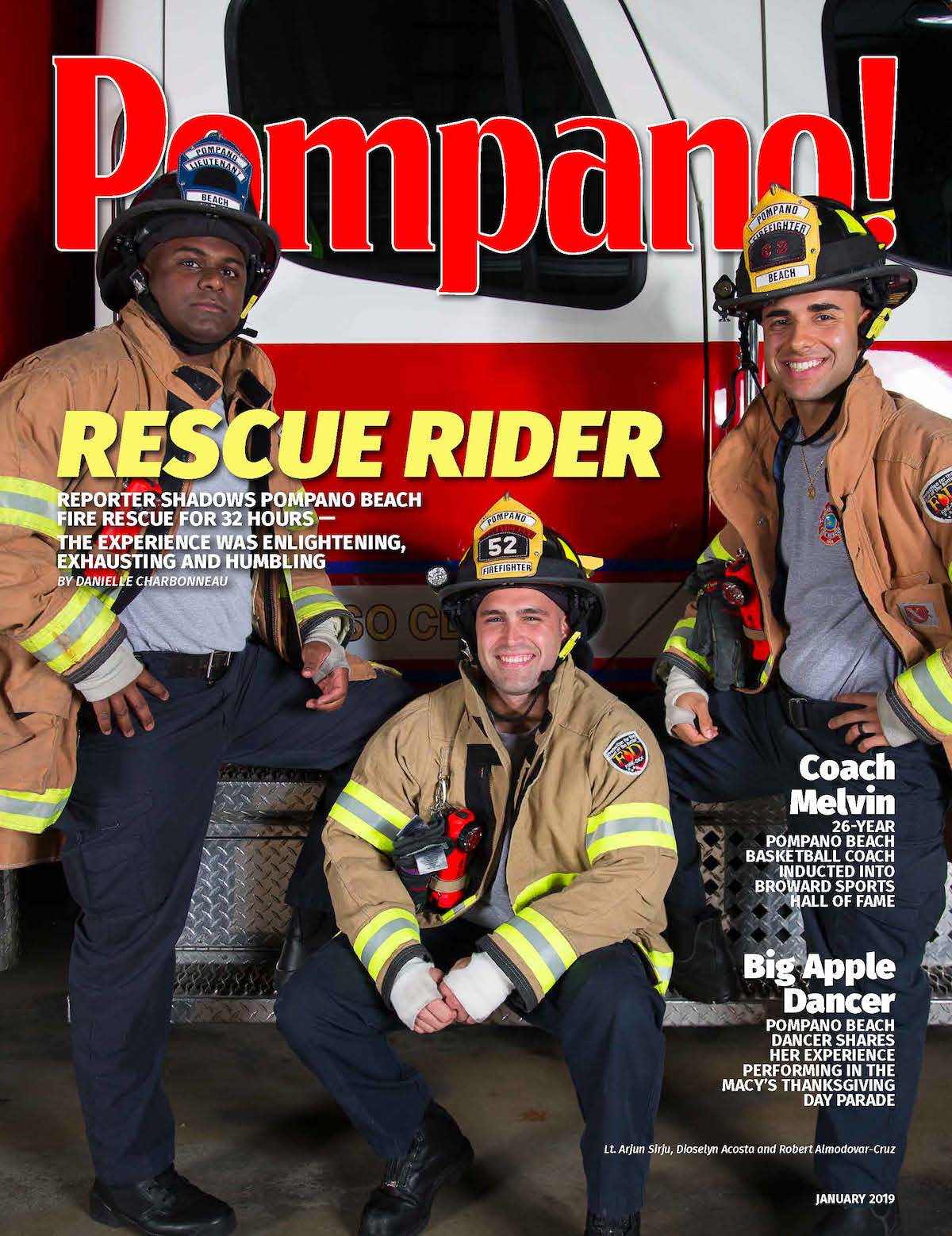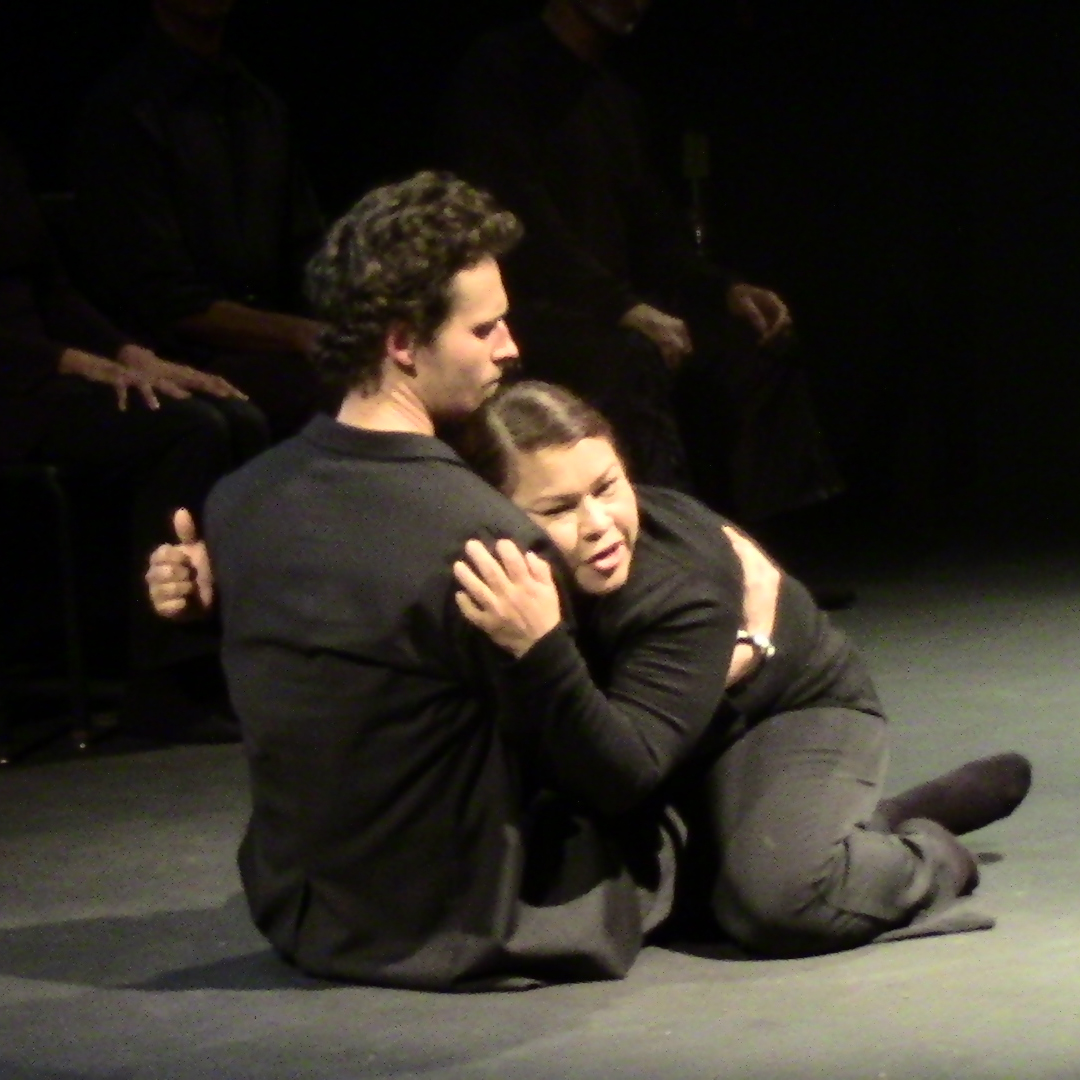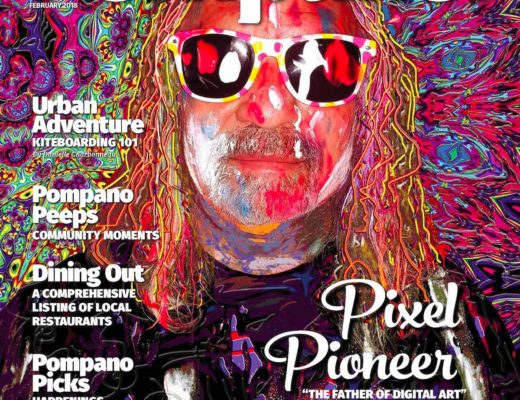Pompano! Magazine reporter Danielle Charbonneau rides along with Pompano Beach fire rescue for 32 hours to reveal the challenges facing the department.
It’s 1:53am when the alarm bell sounds. I listen carefully to its pitch and pattern — there’s different tones to denote if the call has come in for the fire engine, the rescue engine or both. This time the three-tone pitch signals for rescue, which is my cue to sit up, wipe my tired eyes and swing my legs off the side of my assigned twin bed in the long narrow dorm room of Station 63. I slip on my black combat boots and pace rapidly for the door at the back of the pitch dark room which leads to the garage where the rescue and fire trucks rest, plugged in and ready-to-go. I hop up into the backseat of the rescue engine next to Dioselyn Acosta (Dio for short — the crew’s newest member) and watch as our driver Bobby (Robert Almodovar-Cruz) and Lt. Arjun Sirju tap the keyboard of the truck’s laptop dispatch system to find out where we are headed. The call is for a drunk driving accident on Dixie Highway.
As we pull out of the station, the world is dark and quiet. The lights from the rescue truck bounce brightly off street signs and trees, illuminating the road in flashes of red. Bobby keeps the rescue siren eerily on silent as it is almost 2am. Few cars are on the road as we cross the railroad tracks and hang a left onto Dixie Highway from SW Third St. where we see the car — a rusty ’90s Honda, smashed straight into a tree, its trunk now embedded deep into the car’s front end, crushing it like a tin-can. The driver is missing. Pieces of the car have flung onto the sidewalk and there’s blood on the steering wheel and airbag. I peer down the road glancing at slits in fences and bushes, wondering where this drunk driver has stumbled off to. There’s a bottle of Patron in the backseat, which seems an expensive choice for a driver in a beat up jalopy. There’s not much to be done by our team of firefighter-paramedics, so we leave the scene and let Broward Sheriff’s Office (BSO) take over.
When we make it back to the station, Bobby plugs in the rescue engine and we pace inside hoping to slide under warm covers to rest. I get a cold glass of water from the kitchen and think about the number of people who die from drunk drivers every night — one every 48 minutes in the United States, according to the CDC. I don’t even finish my glass before the alarm bell sounds again.
It’s now 2:34am and we rush out the door for our 13th call since the shift began at 7am. And this one’s a big one: a multiple stab wound victim in Northwest Pompano, plus a man suspected to have a gun. As we pull out of the station we see about eight BSO cars fly past us with their lights flashing. A surge of adrenaline rises from my gut to my chest; my pulse quickens.
Bobby momentarily pulls the rescue over to the side of MLK Blvd. to get clearance from dispatch that it’s safe to proceed to the scene where BSO has blockaded the street, now checkered with about a dozen or more cop cars. When we arrive there is a semi-circle of police officers shielding themselves behind their vehicles, guns drawn toward a small house. One officer is on a bull horn telling the suspect to “come out with his hands raised.”

I suddenly feel as if I am watching the climactic ending of an action movie. But this is not a movie — this is real life — and I am now standing in the street hovering over the victim, a young woman in her late 20s, as Bobby, Arjun and Dio tend to her wounds. Her shirt has been cut down the middle to assess the damage to her abdomen.
Arjun and Dio hoist her into the back where they quickly get to work with antiseptics, IV lines and a blood pressure cuff. They move methodically and gracefully as a team. As they do, I can’t help but look away to peer through the front window of the rescue truck and watch as the cops pin the suspect to the ground. Am I really here? The experience feels so surreal.
After assessing the woman, Dio classifies her as a trauma two victim. She’s trauma two — not one — Dio explains, because her wounds are not as deep as initially suspected and her vital signs are strong. Dio radios the emergency room at Broward Health North where we transport the victim and pass her off to some cheery nurses. A BSO officer promptly arrives to take the victim’s statement and our rescue crew departs the hospital. Their work is done for now…but not for long.
Before we even make it back to Station 63, another call comes in: this one’s for a panic attack — a woman, probably in her 50s, is experiencing shortness of breath and a racing heart. We pull up to her home, which coincidentally is located only a few blocks from the scene of the last call. Overhead, a helicopter is flying, assumedly related to the crime scene we had just departed. The woman explains to Arjun that police had come to her door looking for her estranged daughter whom she hadn’t seen in months. The incident had triggered a panic attack. When Arjun determines her blood pressure as non-emergent, we leave her at her home and return to the station.
It’s now 4:03am and the rescue crew out of Station 63 has been working for 21 hours, made 14 calls, transported nine people to local emergency rooms and probably slept, collectively between calls, about four hours — sleep that’s only shallow, waiting for the next alarm bell to sound.
Dio probably slept even less. As the so-called “rookie” of the crew, I spotted him up between calls studying maps of Pompano Beach and getting quizzed on street addresses. Each team member must know how to navigate the city without GPS. As the newbie, Dio is also tasked with extra chores and the 5:30am shift turnover tasks.
In the daylight, when not on calls, the station operates much like a large family home (or at times, a bit like a fraternity house) — shared meals (insanely delicious ones, I might add) prepared together while listening to jams cued up by Bobby (Station 63’s resident DJ), impromptu workout sessions in the gym; a living room full of lazy boys with football on the tube, jokes thrown, belly laughs heard and a deep sense of camaraderie. The crew members discuss their children’s comical debacles, their spouses and their second jobs (which Arjun, who works at an ER on his days off from the firehouse, said are common for firefighter-paramedics). As soon as the alarm bell sounds, however, the station springs to action with the utmost professionalism.
If you’re wondering why I was tagging along, it is because Fire Chief John Jurgle invited me. The ride-alongs were my opportunity to witness firsthand a day-in-the-life of a Pompano Beach firefighter-paramedic. I completed one eight hour day shift (mostly at Station 52), followed a few weeks later by the full 24-hour-long shift at Station 63. The experience taught me quite a lot, not only about challenges facing Pompano Beach’s fire-rescue department, but about our community in general.
 OBSERVATION ONE: CALL VOLUME
OBSERVATION ONE: CALL VOLUME
My first observation was how busy the stations were. On a whole, from October 2017 to June 2018, Pompano Beach Fire Rescue’s six stations responded to an average of 80 incidents a day (21,812 emergency calls). Combined, Jurgle said Station 52 and Station 63 run approximately 50 percent of all the calls in Pompano Beach, which equates to approximately 40 calls per 24-hour shift out of those two stations.
To alleviate that workload, last year the fire rescue department added an additional rescue engine with a full time crew (15 additional personnel) to operate out of Station 52. Currently, only one rescue operates out of all other stations.
At Station 63, the pace rarely slowed; and I was there on a slightly below-average day. According to the most recent report, Station 63’s rescue truck makes an average of 15 calls per 24-hour shift. Station 52 follows closely behind with an average of 13 (split between two rescue vehicles). Some shifts, Arjun pointed out, are much busier than the average, especially during South Florida’s peak season. He recalled one shift when his crew responded to 21 calls in 24 hours.
Pompano Beach Fire Rescue has one of the highest call volumes per capita of any fire rescue department in South Florida — 199 incidents per 1,000 population. By comparison, (according to each department’s most recent, available report), Coral Springs had an average of 119 calls per 1,000 population (Oct. 2016-Sept. 2017), while Coconut Creek had 129 (2017), Miami-Dade 95 (2016) and West Palm 157 (2017). [See table.]
The high call volume and rescue workload seemed to be the most common, pressing complaint from the firefighter-paramedics during both ride-a-longs. Chief Jurgle said he’s very familiar with this complaint from his staff but always tells them to keep perspective.
“Yes we are busy,” he said. “But I try to tell them to keep it in balance…14 calls, three paramedics to make decisions. That means you, as a paramedic, only write about four or five reports in 24 hours and you’re making about 100,000 dollars a year. It’s not a bad job.”
According to a 2014 job bulletin posted by the City of Pompano Beach and listed as continuous, however, the starting salary for a Pompano Beach firefighter-paramedic is $52,626 annually. By comparison, the 2018 national average from 171 entries on PayScale is $51,529.
Chief Jurgle, who has done hiring interviews for the department for 15 years, said he always warns new hires of how busy Pompano Beach Fire Rescue stations can be.
“The last thing I say to every candidate is, ‘Do you know how busy we are?’… They know the expectations when they come here,” he said.

In spite of being busy, Chief Jurgle said the Pompano Beach Fire Rescue Department is ranked “one of the best fire rescue departments in the whole country.” He points to the department’s recent ISO Class One Certification hanging on his office wall, which the department obtained on May 23, 2017. The ISO is an independent organization that ranks fire departments on criteria such as call response time, save rates and property saved, among others. ISO rates 44,670 fire departments across the country and only 242, or 0.5 percent, have received a Class One rating. The City of Pompano Beach historically had an ISO rating of Class Four. In 2010, this improved for the first time to an ISO Class Three. Then in 2015, a Class Two and last year, Class One.
“It’s not an emotional statement from the fire chief when I say ‘we are one of the best fire departments,’” he said. “It’s an independent organization coming in and saying ‘yes you are.’”
Though Station 63 is markedly busy, Chief Jurgle said hiring an additional rescue truck is unlikely, especially considering Pompano Beach voters recently approved a $181 million bond, which includes several items for the Fire Rescue Department, including plans for a brand new SW fire station at the corner of SW 36th Ave. and McNab Road where one of the two rescues from Station 52 will re-locate. The bond also includes plans for a fire rescue and logistics complex, replacing two outdated stations (52 and 61) and renovations to the Public Safety Complex. Hiring an additional rescue woule be expensive.
“The personnel would be about 1.5 million, the rescue truck would be about $400,000, so you’re looking very quickly at two million dollars,” he said. “A good analysis needs to be done though…We run a lot of calls out of this station [63], but I think it’s more important to look at calls per unit.”
By unit, Jurgle means total rescue vehicles (rescue and fire trucks combined). Because firefighters are also trained paramedics, a fire truck can be sent to emergencies if needed.
The department can also utilize mutual aid from nearby fire departments. In 2017, Pompano Beach Fire Rescue utilized mutual aid 64 times. By comparison, the department provided mutual aid calls 143 times, indicating a more-than-fair exchange.
“I don’t ever want to come off as being greedy,” said Chief Jurgle. “The greatest thing for us is public trust, and I never want to lose that public trust by coming off as greedy firemen.”
OBSERVATION TWO: EMOTIONAL BAGGAGE
During my two ride-a-longs, I took part in only one call with a fatality. The call was a DOA (dead on arrival). The woman was an elderly woman living in John Knox Village. The woman died as peacefully as one could possibly hope to — in her own bed, wearing her pale pink pajamas. Seeing her stiff, lifeless body was not as emotionally jarring as witnessing a BSO officer share the news of the woman’s death with her daughter who waited anxiously in the living room. I watched as the BSO officer expressed his sympathies. The daughter fell, crumpling into an armchair and clutching her gut in grief.
I felt so odd engaging with this woman’s life for only a brief moment, but for probably one of the most emotional of her life. We were in and out of the home in a matter of minutes, leaving BSO and the coroner to complete their tasks. The whole scene felt so routine — as if the paramedics and BSO officers had done it a million times (as they probably have).
It struck me then that it must feel strange to regularly witness people’s most vulnerable moments and then leave. In many cases, the paramedics transport an individual to a local emergency room and leave them without ever knowing what happens after. I would find this aspect of the job difficult — the lack of closure.
“It can be a thankless job at times,” said one firefighter-paramedic.
Not knowing on the backend of an emergency is probably not as frightening, however, as the not knowing on the front — how from one day to the next, you never know what call you might get, what emergency you might encounter. While the paramedics seem to thrive, and maybe even enjoy the rush of this aspect of their jobs, I imagine not everyone could face the unknown daily with such courage.
In responding to the DOA, I was also struck by how each paramedic seemed to have either an innate or highly-developed ability to compartmentalize their emotions, putting feelings on the back burner so they can focus on the job. Several acknowledged, however, that the emotional baggage does pile up.
“At the end of a shift you are completely mentally burned out,” said Arjun. “There’s sometimes when I don’t even have dinner at night. I just don’t want to see people, I don’t want to talk to anyone.”
The potential for firefighter-paramedics to experience PTSD, sleep deprivation and overwhelming emotions is significant. In March 2016, Rich Sandell, a Pompano Beach firefighter-paramedic tragically committed suicide.
“Now, more than ever, we are aware of the impact that being in this business has on people’s mental health, both in the immediate and the cumulative effects, ” said Chief Jurgle.
Theresa, a firefighter-paramedic who works the fire engine out of Station 63, recounted the horrific day the week prior when two young children were fatally burned alive while napping, their older sister having gone to the gas station. The crew for that incident were deeply scarred.
“That kind of incident is impactful on people that do this business no matter how long they’ve done it,” said Jurgle. “Anytime there is a major critical event such as that we do critical stress debriefing with our folks.”
On an industry-wide basis, the state of Florida recently passed legislation in March 2018 that provides expanded workers’ compensation benefits to Florida first responders diagnosed with PTSD linked to the job. The bill, which was signed by Gov. Rick Scott also requires local governments to provide training for mental health awareness, prevention and treatment.
 OBSERVATION THREE: HEALTH HAZARDS
OBSERVATION THREE: HEALTH HAZARDS
“Beyond mental health, the other big concern in this business is cancer,” said Chief Jurgle. “Cancer is one of the leading killers of firefighters right now, and sometimes it happens to you after you leave the business.”
According to the Journal of Occupational and Environmental Medicine, firefighters are 102 percent more likely to be diagnosed with testicular cancer, 53 percent more likely to have multiple myeloma, 51 percent more likely to have non-hodgkin lymphoma, 39 percent more likely to develop skin cancer, 32 percent more likely to get brain cancer, and the list goes on.
Jurgle said cancer is now perhaps an even bigger killer of firefighters than it was in the past, partly because of the types of fires they encounter.
“There are a lot of synthetics that burn hotter and give off carcinogens,” he said. “Unfortunately our firefighters — although they are well equipped with breathing apparatus, air packs and the latest gear — still experience opportunities to absorb some of those carcinogens.”
To stay proactive, Jurgle said the Pompano Beach Fire-Rescue department does life scan screenings for various cancers throughout the body and hosts seminars to educate employees on the best practices for avoiding toxins — such as cleaning their gear thoroughly.
As the Pompano Fire Rescue Department rebuilds and redesigns their stations, Chief Jurgle said the department is taking into account the fumes and carcinogens the engines emit.
“We will have systems in place that either expel or capture those fumes,” he said.
OBSERVATION FOUR: THE TRICKLE DOWN EFFECT
One stark observation I made throughout my two ride-a-longs was how societal challenges, such as the opioid epidemic, the growing elderly population, homelessness and mental health disorders, trickle down to the fire department.
Mental health was a factor in multiple calls we responded to. The first was an older woman whose family had called 911 worried about the woman as she had left home with a bottle of pills and had checked in to a cheap roadside motel not far from her home. The family was concerned she wanted to kill herself.
On another, we encountered a disturbed bystander. We had been dispatched to an unrelated call at the home of a man who had cancer and was vomiting blood when a hyper-active neighbor greeted us outside. While we were in the house tending to the man, the neighbor out front began displaying definite signs of a mental disorder. She ran frantically up and down the street, swung open all the doors of the rescue truck, spread orange cones haphazardly across the road, wiped her sweat on the ornamental American flags on the hood of the fire truck and blabbered incoherently about it being Christmas (though it was September). The paramedics were familiar with the woman as they had responded to calls on her before. They very professionally invited her to get her blood pressure taken, then tactfully guided her home.
While firefighter-paramedics are not required to take courses on confronting the mentally ill, I imagine such courses would be tremendously useful. The experience also made me think about the empathy required by the job. Encountering such a wide range of personalities demands robust patience and people skills.
Related to mental health, addiction played a factor in several calls I participated on, including an alcoholic seeking detox and an addict who had been hit by a car. While I did not participate on any calls responding to an opioid overdose, several firefighter-paramedics discussed the ravages of the epidemic. One firefighter-paramedic recounted the story of a shift in which they ran six calls on opioid overdoses in 24 hours. He said they ran out of Narcan (the medication used to reverse an opioid overdose) and had to restock mid-shift. Another firefighter-paramedic told me of a day when he ran multiple overdose calls on the same person in one shift.
According to departmental records, the Pompano Beach Fire Rescue Department responded to 487 opioid overdose calls from October 2017 through October 2018.
Another common call we responded to were emergencies involving elderly patients, including one senior who flew off the back of a treadmill, another who uncharacteristically refused to get out of bed, a man experiencing shortness of breath, another who lost feeling in his arm and a woman with tightness in her chest. In 24 hours, five of our 14 calls were for geriatric patients.
One firefighter-paramedic expressed concern over these calls becoming progressively more common as the population of Pompano Beach ages. When rescues are tied up on such calls, he said, the department relies more heavily on mutual aid from other fire departments. Adults over the age of 65 currently make up 22.5 percent of Broward County’s population, totaling roughly 430,000 residents. The county is also facing the “Silver Tsunami,” when the population of over-85 individuals is projected to balloon by 31.9 percent by 2030.
An increase in the homeless population (which in Broward has risen by 6 percent in the last year), the rapid development of Pompano Beach and general population rise were also areas of expressed concern by the firefighter-paramedics who said they hope the city will consider such factors when determining future staffing.
FINAL THOUGHTS
While I cannot, in any capacity, truly know what it is like to be a firefighter-paramedic day-in and day-out — the emotional and physical toll the job takes on a person — I am deeply grateful to have stepped into their world, if only for 32 hours. To confront harsh truths about life, death, disease and humanity is quite difficult. I imagine it could chip away one’s positive outlook. Yet the crew members I spoke with expressed a sense of deep gratitude for life, bolstered by what they see on a daily basis.
I have a new appreciation for the job — one that involves serving people from all walks of life in their most fragile moments — one which often bears witness to the darker sides of humanity — a job that requires the emotional fortitude to witness horrific tragedy and the patience to deal with difficult people — and a job that, every day, forces one to acknowledge the precariousness of life.






